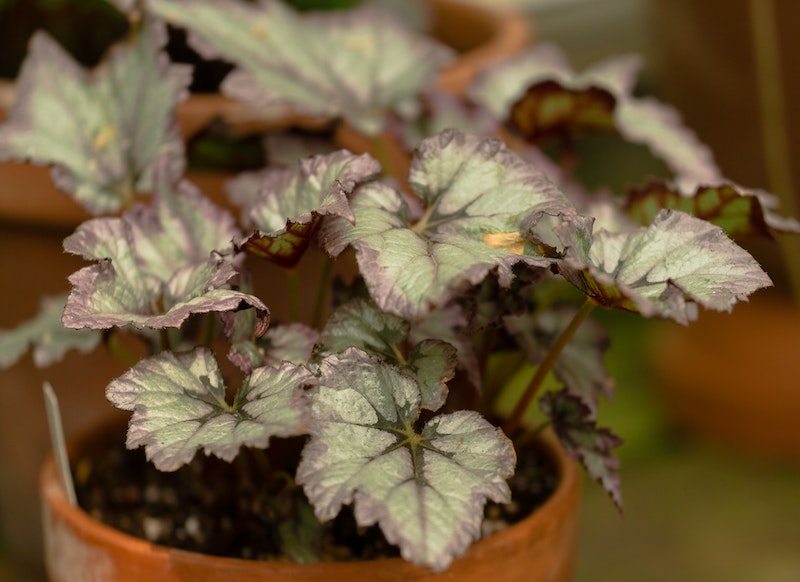Heuchera or Coral Bells is a perennial plant often grown for its colorful foliage. This cold-hardy plant can live in various conditions, adding bold color to a landscape. Understanding common diseases and treatments enables you to provide the best care possible for Coral Bells to keep your plants healthy and thriving.

Coral Bells Downy Mildew
Downy mildew is a water mold that grows on foliage. This mildew thrives in damp conditions and, if left untreated, can spread throughout a plant.
Identifying Downy Mildew
Downy mildew looks like small yellow spots on the leaves. The underside of an infected Coral Bells leaf will develop a fuzzy gray mold. Leaves are unable to conduct photosynthesis and will wilt and die.
Treating Downy Mildew
Remove infected leaves at the first sign of downy mildew. Destroy the infected foliage to contain the spread. Treat Coral Bells with downy mildew using a fungicide. Apply fungicide for several weeks to ensure there is no remaining mildew left. Thin the Coral Bells or transplant healthy plants to another area to improve airflow and prevent future outbreaks of downy mildew.
Coral Bells Botrytis Gray Mold
Botrytis gray mold is caused by a fungus that thrives in damp, humid conditions. This mold can impact a variety of plants, including Coral Bells. Plants grown in partial shade are more susceptible to botrytis, especially later in the summer when heat and humidity are high.
Identifying Botrytis Gray Mold
Coral Bell plants infected with botrytis will have a gray, fuzzy mold growing on the surface of the foliage. This plant is commonly grown for its foliage, but infected flowers will have a deformed appearance before turning brown.
Treating Botrytis Gray Mold
Remove infected foliage and flowers if your Coral Bells have botrytis. Treat the plant with a fungicide to remove any remaining spores. Improved air circulation will prevent future outbreaks of gray mold, so thin the plants so air can flow around the foliage.
Coral Bells Leaf Spots
Leaf spots on Coral Bells are a fungal infection. This fungus emerges in damp conditions, so humid weather, partial shade, and a leafy plant like a Coral Bell are a likely mix that will result in leaf spots.
Identifying Leaf Spots
Leaf spots appear on the foliage as white circular spots with a black or brown outer ring. One leaf can have multiple spots that inhibit photosynthesis, eventually causing the leaf to wither and die. An untreated Coral Bell plant will die as the fungal infection overwhelms the plant.
Treating Leaf Spots
The first step to treating leaf spots on Coral Bell plants is to remove the infected vegetation. Trim and destroy the leaves to prevent the fungus from spreading to other plants. Treat infected Coral Bells with a fungicide. Divide the plants to improve air circulation, reducing outbreaks of fungal infections like leaf spots.
Coral Bells Powdery Mildew
Powdery mildew is a fungal disease common in plants with broad foliage, like Coral Bells. Crowded growing conditions, limited light, and increased humidity contribute to a powdery mildew outbreak.
Identifying Powdery Mildew
Powdery mildew first appears as faint yellow spots before transitioning into whitish-gray dots that later form a fuzzy texture on the surface of leaves. Infected leaves wither and die as the mildew overtakes them.
Treating Powdery Mildew
Treat powdery mildew by removing infected leaves and spraying the plant with a fungicide. Destroy the pruned vegetation to contain the mildew and prevent the spread to other plants. Thin or divide Coral Bell plants to increase airflow, which prevents mildew and fungal infections.
Coral Bells Rust
Rust is a fungal disease that does not often kill a plant but does cause stunted and diminished growth. The rust spores can be carried by wind or splash from one plant to a neighboring plant by water. Like most fungal diseases, rust thrives in damp, crowded conditions. Overgrown Coral Bell plants in partial shade are prime for a rust outbreak.
Identifying Rust
Rust in Coral Bell plants appears as raised white or yellow spots on the top of the foliage. The underside of the leaves will have reddish-orange blister-like growths. Eventually, infected leaves will fall from the plant.
Treating Rust
Treat rust on Coral Bell plants by trimming and destroying infected leaves. Spray the plant with a fungicide to kill any remaining spores. Remove debris or dead plant matter from around the plant, water the ground, and keep the leaves dry when watering Coral Bells. Rust spores can be spread via water, so keeping the plant dry prevents spores from moving to other leaves or plants.
Coral Bells Disease Chart
|
Disease |
Identifying |
Treating |
|
Downy Mildew |
Yellow or white spots on leaves |
Proper air circulation |
|
Botrytis Gray Mold |
Gray mold and deformed, brown flowers |
Fungicides & air circulation |
|
Leaf Spots |
Ringed spots on leaves |
Fungicides & air circulation |
|
Powdery Mildew |
Yellow or white spots on leaves |
Fungicides & air circulation |
|
Rust |
White or yellow spots on leaves |
Fungicides & air circulation |
Sources:
"Coral Bells Heuchera." The Connecticut Agricultural Experiment Station. portal.ct.gov
"Heuchera (Alumroot, Coral Bells, Heuchera)." North Carolina Extension Gardener Plant Toolbox. plants.ces.ncsu.edu
